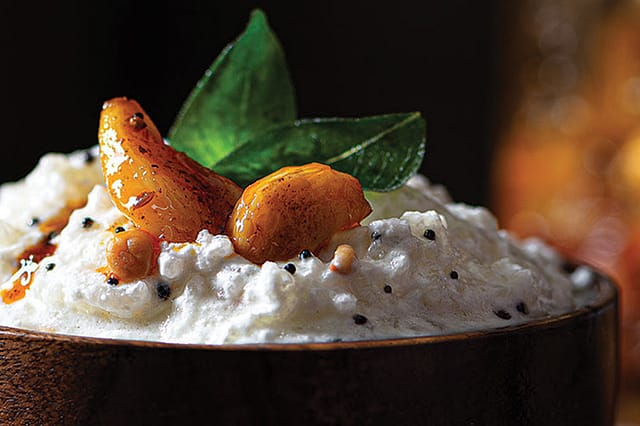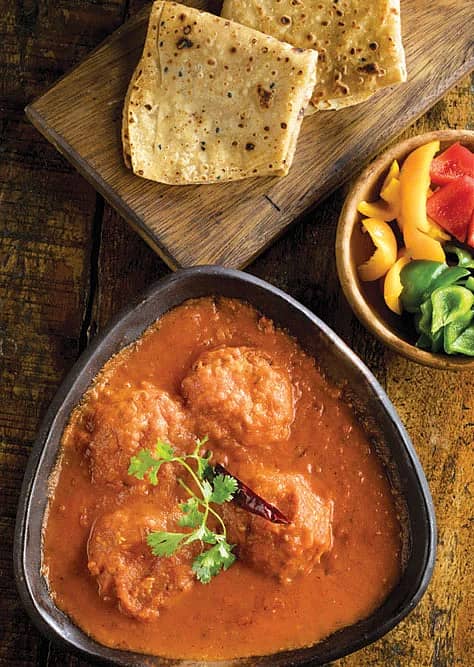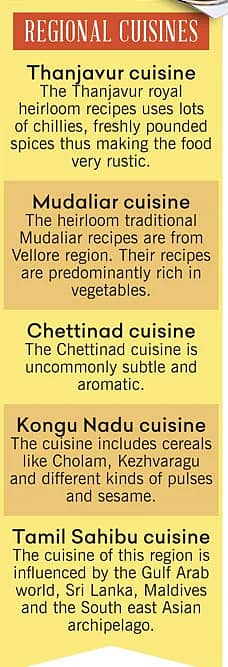Cuisines of the Tamil Land

The darkness of the night is intercepted by the bells from the nearby Sri Ranganathaswamy Temple serving the naivedyam to the reclining resident deity – Ranganatha. Naivedyam is food offerings prepared and served to the temple deity. The temple is suffused with scent of ghee which is wafting from the Temple's Kitchen. Raja Mani, the cook is melting down the jaggery into brown bubbly syrup that will wash over the mound of the rice, donated by a devotee. He hoists the brass cauldron and adds a liberal dosage of ghee and handful of aromatic spices into it before he enters into the sanctum sanctorum.

The inscriptions of the suddhannam (boiled white rice) is inscribed on many walls of the temples belonging to the Chola period. We also find the selvar appam – a delicious recipe made up of rice, cumin, a dash of pepper, unrefined sugar, banana and coconut – which almost dates back to 800 years ago with little change in taste, still served in many temples across the state.
SANGAM LITERATURE AND ANCIENT TAMIL CUISINE
As per the Sangam literature, the ancient Tamil cuisine can be broadly divided into five traditional landscapes – the Kurinji (the mountains) , the Mullai (the forests), the Marutham (agricultural lands), the Palai (the desert) and the Neithal (the coastal areas). The food depended on the availability of the resources that the land has to offer. The Kurinji people often ate honey and tuber. The Mullai people often gorged on wild boars and cooked meat in the direct fire (vakkuthal). As the Marutham were predominantly the people of the plains, the vegetables dominated their platter. However, they also ate meat, white rice, spinach, pulses, cereals and pickles. There is a specific mention of a recipe of white rice accompanied by a thick curry of crab flesh and ridge gourd.

In one of the ancient texts of Sangam literature, the poet is treated in the palace of a Chola king where he was served – delicious skewered goatmeat, rice, crispy fried vegetables and over 16 varieties of dishes as part of the lunch.
Fresh frothing buttermilk and bamboo rice accompanied by a kozhambu made up of jackfruit seeds, raw mangoes and tamarind extracts are some long lost recipes recorded in the Tamil literature.

The people of Palai and Neithal regions often preferred sundried and fried foods. Pickles were often sun-dried and preserved for months. During the harvest of paddy in the deltaic region, fishes like Vilangu, pothi, theli and valai were quite popular as the staple menu of the region.
There is also mention of Paalsoru – the Milk Rice which is made up of tender coconut milk and rice, it is generally accompanied with seeni sambol or lunumiris which is nothing but tantalising chopped onions and chilli flakes.

TAMIL REGIONAL CUISINE
The Tamil regional cuisine is broadly categorised in to five regions – Thanjavur cuisine – Mudaliar cuisine – Chettinad cuisine – Kongu Nadu cuisine – Tamil Sahibu or Tamil Muslim cuisine
Delightful Thanjavur cuisine
The cuisine of Thanjavur is a mix of traditional Brahmin, Mukkulathor and Maratha cuisines, drawing from the communities that have lived in and around the area. The Maratha dynasty which ruled from 1674 -1855 AD had heavily influenced the cuisine of this region. The Kola urundai is an example which is very similar to Marathi Shunti kebab. In this, the fish is delicately tied with banana leaves into a ball shape and deep fried.


The Thanjavur royal heirloom recipes uses lots of chillies, freshly pounded spices thus making the Cuisinesfood very rustic. The mashyache kebab (pan-fried poppy seeds and green chilli-smeared fish fillets), komdiche kebab (chicken kebab with coriander, pepper and ginger), kesari maas (dry mutton mince with saffron and spices), kelyachi bhaji (raw banana tossed with karivadagam and hurit, a mixture made by roasting lentils, rice and sesame seeds and ground into a coarse powder) are a part of regular South Indian meal. But what makes the food of the Thanjavur royal kitchen so unique is the distinct and unmistakable influence of the Marathas.



The traditional Iyer Brahmin households serve food in a sequential pattern. The typical meal starts with cooked rice consumed with paruppu (cooked lentil) and ghee, then rice with sambar (thick lentil soup with vegetables) accompanied by a vegetable curry, followed with rice and rasam (thin watery soup) and it ends with rice and yogurt accompanied by a spicy pickle/ narthelai podi( a powder made with tender citron leaves)/ small mangoes in brine solution called vadu mangai.
Interestingly, sambar was invented while making dal, instead of kokum, tamarind was used.

Another typical dish of Thanjavur is Keerai masiyal. Green leafy vegetables are cooked along with lentils in a clay pot along with ghee.
The famous Thavala Adai are pancakes made of lentils and rice batter. The adai usually contains onions and chillies in the batter and is served with chutney. The batter is made from rice, Urad dal, bengal gram and toor dal.
Delectable Mudaliar cuisine
The Mudaliars were historically rich farmers or the agriculturalists who had made many breakthroughs in the field of agriculture. They are also flushed with money (mudra) perhaps, from where the word Mudaliars had come into existence.
The heirloom traditional Mudaliar recipes are from the Vellore region. Their recipes are predominantly rich in vegetables. The ingredients are generally locally sourced and simple but the flavours are beautifully complex with combinations of vegetables.

Some dying recipes include Vazhaipoo Thattai , a vada made of banana flower and Bengal gram, full of luscious flavours inside. Another vada used as a starter is the Karnakezhangu Vadai which are vadas made with yam, green chillies and aniseed and more. The Raal Varuval is grilled masala fried prawns which trigger the taste buds.
The Mudaliars are known for their weakness of brinjal. The Kathirikai Chops; small brinjals cooked with a spicy masala of onion, tomatoes, peppercorns and coconut, is a dish treat to all, it is generally accompanied with piping hot appams. One of the diminishing recipes is the Vendhi Keerai Perattal with methi (fenugreek) leaves cooked with urad dal and green chillies and then tempered with mustard seeds. The simplest yet most delicious vegetarian preparation one can really enjoy. The Chow Chow Curry, another delightful yet obscure vegetable which looks like the bottle gourd is finger licking delicious.

The cuisine gets a unique flavour because of the usage of Tamil spices which includes mustard, cumin, fenugreek, shallots, etc. These spices are sundried, made in the form of balls and kept in jars for a long period of time. They are used during the monsoon seasons. One famous dish from this region is Pangti Korumbu. Pangti means a row of guests and Korumbu is mutton. This dish is made with the Tamil version of five spices.
Last but not the least, is the Elaneer- tender coconut water with mint leaves is a refreshing drink served before the meal.

The Chettiars are the rich moneylenders and traders mostly hailing from Sivagangai district, which is a semi-arid region. Hence, the vegetables are sun-dried to retain their original nutritional values. The Chettinad cuisine is uncommonly subtle and aromatic. As they were involved in the spice trade, they have added Tellicherry pepper, Madagascar cloves, Ceylon cardamom etc. to the staple food of South India. Their food has a distinctive Burmese flavour as they use sticky red rice for their dishes. The dishes are served on banana leaves and are arranged in a specific sequence on the banana leaves. The Chettiyars often believe in serving their dishes in odd numbers of seven or nine. The food is mostly vegetarian however, some spicy non-vegetarian food also found its way into the repertoire.Some popular Chettinad dishes are: idiyappams (string hoppers are sauteed along with chilli paste and fresh vegetables), various paniyarams (urad dal, green chillies, ginger, curry leaves and mustard seeds), kozhakattai urlai roast (a tasty dish of baby potatoes simmered in hot spices and tomatoes). The secret of the Chettinad cuisine is the use of kalpasi (black stone flower) and dried pods.

Unique Kongu Nadu cuisine
cuisineThe cuisine of Kongu Nadu is basically from the south-west of Tamil Nadu which are bordered with Kerala, like Coimbatore and Salem. Kongu Nadu cuisine predominantly uses rice as its base with a collection of exotic recipes created by the people of the Kongu region. As it is also native to an arid climate, the cuisine includes cereals like Cholam, Kezhvaragu and different kinds of pulses and sesame. Food is served on a banana leaf. Eating on a banana leaf is an old custom and imparts a unique flavour to the food and is considered healthy. Idli, paniyaram and steaming hot appams are popular dishes. Kongu Nadu cuisine does not involve marination of any raw material and as a result the food has a different taste and unique texture. The best quality turmeric is grown in the region and this is an important ingredient in the cuisine. Turmeric is added into curries, which gives the food a deep yellow colour and a distinct aroma. The traditional Kongu people were mostly vegetarians. Opputtu is made with rice, chickpea, palm or cane jaggery, cardamom and ghee. One of the popular non-vegetarian dish is Dindigul Biryani. Small meat pieces along with the unique flavour of Seeraga Samba rice is added to the biryani.

A much cherished Navarassa curry which is a mutton curry having a burst of all nine flavours is a much talked about dish of this region.
Exotic Tamil Sahibu Or Tamil Muslim cuisine
The cuisine of this region is influenced by Gulf Arab world, Sri Lanka, Maldives and the South east Asian archipelago. Fish powder and pandan leaves are brought to be believed from Maldives. A special mention in this cuisine is kanava karuvad (a specific variety of dried squids).
The extreme south of Tamil Nadu, the Coromandel Coast is the epicurean home for the Tamil Muslims. Intermingling of Arab traders and the local women during eight or ninth century resulted in formation of the population near these coastal towns like Kilakarai, Kayalpatnam etc. There are Kayartattnam or shepherds or men who used to trade on ships. This community is mostly sea faring community who relied on maritime trade, fishing and pearl diving as a source of income.
Other exquisite dishes of this region includes calamari deep fried with curry leaves and dry chillies, murunggai keerai (moringa spinach), puliyanam (chilled coconut milk based dish), maasi thuvayal (dried tuna and chanadal chutney). Idiyappam with meen anam (barracuda or seela mean fish curry) is a quintessential Tamil dish of this region.
SWEET SAVORIES FROM TAMIL NILAM
A typical full course Tamil meal consists of all six tastes or Arusuvai as called in Tamil. They are sweet, sour, salty, bitter, pungent and astringent. Thus, no meal can be treated as complete without the desserts.The indulgent desserts of Tamil Nadu are exquisite and nutritious. Most are healthy preparations using less sugar and include healthy proteins like green gram and chickpea. Some of the mouth-watering traditional sweets of Tamil Nadu are:
Payasam: A thick, creamy dessert, Payasam is ubiquitous throughout the state. Ingredients used mostly include vermicelli, rice, chickpeas or green gram with the base being milk or coconut milk. It is prepared during all auspicious occasions including festivals.
Rava Kesari: Brightly coloured with saffron (Kesar), this dessert is all buttery, inviting and similar in texture to sooji halwa.
Mysore Pak: A bewitching dessert, "king of all sweets" – made from gram flour, sugar, and fragrant cardamom powder roasted in oodles of ghee. It is then cooled and cut into squares. Meant for special festivals like Navaratri and Deepavali.
Paniyaram: A quickest sweet snack when one has a craving for sweet. It is made from idli batter that's been sweetened with jaggery. Coconut and cardamom powder are added to highlight its taste.
Sakkarai pongal: Sweet pongal is a delicious South Indian dish made with rice, moong lentils, ghee, jaggery or sugar, cardamoms and nuts. It is traditional dish mostly made to offer the gods on special occasions & festivals. Sweet pongal is known as sakkarai pongal in Tamil. It is made in many traditional South Indian homes on the day of Makara sankranthi or pongal festival. The dish is said to have been prepared by our ancestors to signify and celebrate – abundance and prosperity after the harvest.
Ukkarai: A popular dessert served during Deepavali in Chettinad, it's made of steamed green gram and Bengal gram flavoured with jaggery, coconut and cardamoms.
Kozhukkattai: Something similar to Modaka. It is a sweet dumpling made from rice flour and has a filling of coconut and jaggery. These melt-in-the-mouth snacks are offered to Lord Ganesha during Ganesh Chathurthi.
Adirasam: A sweet delicacy bonding the household of Tamil Nadu and gorged during Deepavali. It is a deep fried snack made up of jaggery and rice flour. Very similar to "Malpua" of the north.
Aside from these, there are other sweets like the famous cashew-flavoured macaroons (found in the ports of Tuticorin), maladu, karollappams, thirvadhirai kali, mundrikothu, makkan peda, etc., to tempt and tantalize the taste buds.
It is knowing and appreciating the value of a cuisine that was perfected some time ago and has been gifted to us, only to be passed on again to the next generations makes for many of the heirloom recipes shared here.
So, next time you visit Tamil Nadu explore beyond idli, vada and sambar. Instead savour each regional cuisine that boasts of unique cooking methods and spices. They have been backed with heirloom family recipes, ancient culture and traditions, community history and external influences.
(Website: www.tamilnadutourism.tn.gov.in I Social Media: @tntourismoffcl)
(A marketing initiative by Open Avenues)
